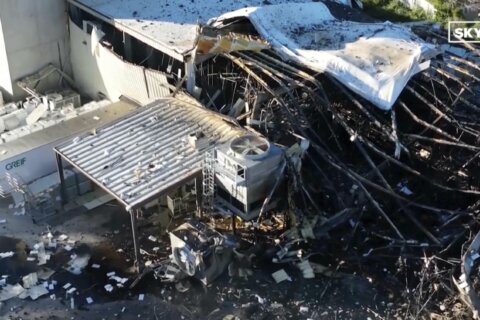NEW ORLEANS (AP) — Two days after Hurricane Francine knocked out power for nearly half a million people in Louisiana, Alexandra Canary was still waiting for the electricity in her area to come back online.
As her fridge continued to thaw out, the New Orleans resident began to clean out condiments at risk of spoiling. One of her small dogs watched from the couch, panting. Without air conditioning the home heated up quick, as the heat index reached 93 degrees Fahrenheit (33.9 degrees Celsius) on Friday.
“It’s been tough trying to sleep, or even live,” Canary, who is in her 70s said. “Somedays it is actually cooler outside than being in the house.”
Frustration mounted across New Orleans, as crews for the city’s electrical provider, Entergy, worked to restore power.
“Every single storm, every one, no matter how big or how small, the same thing happens,” said Rudy Cerone, 71, referring to the power outages. “Entergy just doesn’t seem to take the necessary preparatory actions to harden this system to provide the power that we’re paying through the nose for.”
An Entergy New Orleans spokesperson said the city had restored power to more than 40,000 customers since Thursday and that many more would regain electricity by the end of the day Friday. Around 6,500 Entergy customers in the city lacked power as of Friday afternoon, part of about 95,000 customers in Louisiana still without electricity, according to the tracking site poweroutage.us.
The spokesperson also said the information used to update outage numbers comes from crews in the field.
“These steps take time, and our teams are committed to providing customers with the latest restoration information as it is available,” the spokesperson said in an emailed statement.
After losing electricity Wednesday night, Richard Smith, 56, owner of Adams Street Grocery & Deli, had been running his New Orleans store off a generator. But the electricity source wasn’t enough to power the deep fryer machine. So customers had to settle for cold cuts instead of hot fried chicken sandwiches, and pay in cash instead of with credit cards, he said.
Power was restored late Friday afternoon, not a moment too soon.
“This is the time we are supposed to be busy and we lost a lot of business,” Smith said. “A lot of people thought we were closed.”
Louisiana Gov. Jeff Landry said electricity is the major issue facing the state since Francine rolled through.
“The biggest challenge we have had in this storm is utilities – trying to get the power back on,” Landry said at a news conference Friday afternoon.
Prior to Francine making landfall, utility crews were pre-positioned in areas that would likely be impacted by power outages, Landry said.
Davante Lewis, an elected member of the state Public Service Commission that regulates utilities, did a ride along on Thursday with Entergy to assess the damage. He said much of it was broken branches and trees — likely weakened by recent drought conditions in the state — on power lines.
“I think what we are seeing right now is a lot of vegetation issues and we just don’t have enough hands to move it (debris) that fast or enough hours in the day to safely do so in sunlight,” Lewis said.
Utility crews from Oklahoma, Florida, Texas and elsewhere are working to restore power, Lewis said, with projections for full restoration by Sunday.
“Any amount of time without power in Louisiana, especially for vulnerable communities, is too long,” Lewis said. “But we have seen restoration times a lot shorter than some of the earlier predictions and we are faring better.”
The storm, which drew fuel from exceedingly warm Gulf of Mexico waters, came ashore Wednesday in Louisiana with 100 mph (160 kph) winds and drenched a large swath of the South, including parts of Arkansas and Florida. Forecasters say the storm’s slow progress will mean days of heavy rain in the Southeast, creating a flash flooding risk.
Another 3 to 6 inches (8 to 15 centimeters), with about 8 inches (20 centimeters) in some locations, were expected in parts of central and northern Alabama through Sunday. In northeastern Mississippi, western Tennessee, western Georgia and the Florida Panhandle, another 2 to 4 inches (5 to 10 centimeters) was expected.
No deaths or serious injuries have been reported in Francine’s aftermath.
Rushing water nearly enveloped a pickup truck in a New Orleans underpass, trapping the driver inside. A 39-year-old emergency room nurse who lived nearby waded into the waist-high water with a hammer, smashed the window and pulled out the driver. The rescue was captured live by WDSU-TV.
“It’s just second nature I guess, being a nurse, you just go in and get it done, right?” Miles Crawford told The Associated Press on Thursday. “I just had to get to get him out of there.”
In the coastal community of Cocodrie in southern Louisiana, where many families own seasonal homes along the bayou for fishing, police guarded a road to prevent looting as people cleaned their properties.
For many in the area bordered by bayous, swamps, lakes and the Gulf of Mexico, threats of flooding and hurricanes have become a way of life, Lafourche Parish Sheriff Craig Webre said.
Over the years, the area has become more resilient against storms, improving drainage and pumping stations and replacing roofs that can better withstand hurricane-force winds. Residents are also evacuating more quickly when there are significant storm threats, Webre said.
“This population is very resilient. They’re very independent. They’re very pioneering,” he said.
___
Cline reported from Baton Rouge, Louisiana. Associated Press writers Kevin McGill in New Orleans and Curt Anderson in St. Petersburg, Florida, contributed to this story.
Copyright © 2024 The Associated Press. All rights reserved. This material may not be published, broadcast, written or redistributed.






